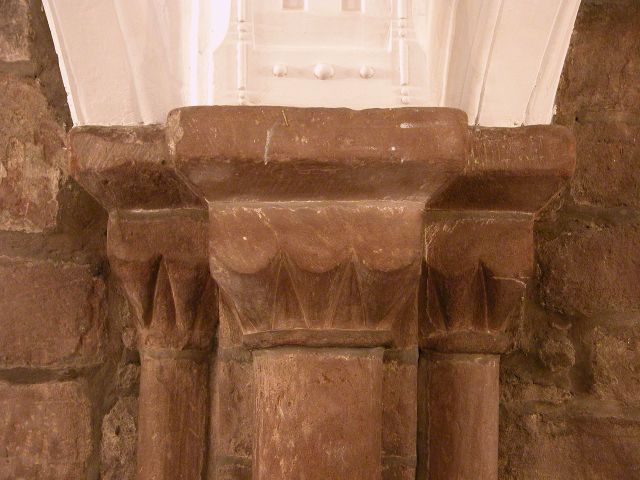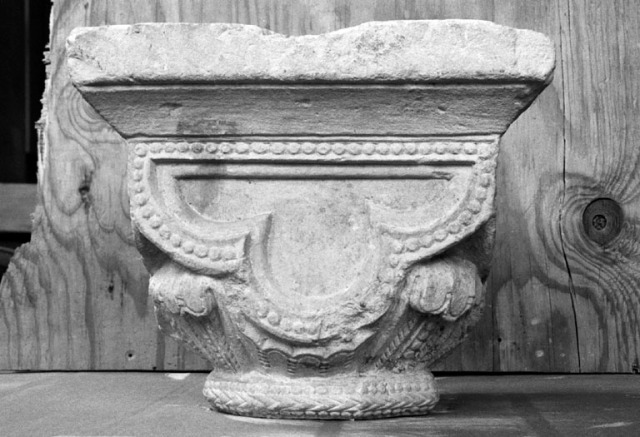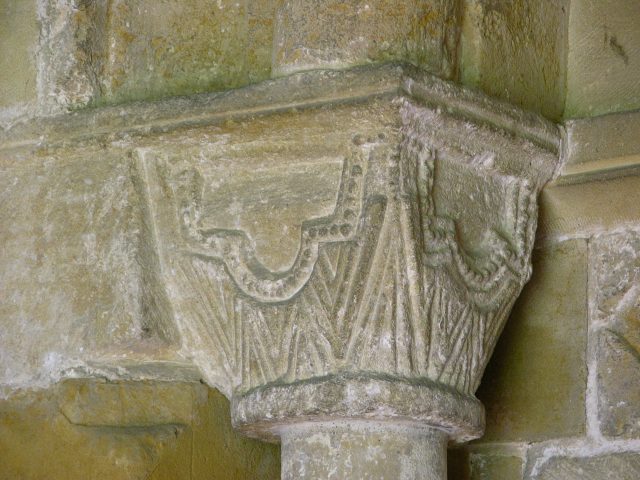Part 1 of my series on cushion and scallop capitals introduced these widespread and enduring features, and in this second part I will look at some ways in which the basic forms were varied and elaborated.
The first and commonest forms of elaboration affected the shields of the capital and the cones below them. The loose capital in the church of St Peter & St Paul, St Osyth (Essex), shown above, has sheathed cones, and elsewhere we might find wedges of various profiles or cylindrical rods between the cones.

Capitals at St Anselm’s Chapel, Chester Cathedral
Thus the vault respond capitals at Chester Cathedral shown above have triangular wedges between the cones, except for the left capital which has conical wedges. There is a limit to the visual stimulation to be gained from this sort of thing (although painting with bright colours would certainly have livened things up), but the shields themselves also offer opportunities for decoration. They can be recessed and framed in various ways, or relief ornament can be added to their semicircular fields.

Nave arcade capital at St Mary, Grendon (Northants)
The multi-scallop nave arcade capitals at St Mary, Grendon (Northants) are carved with several variations on this theme. The example shown here has half-daisies in the shields, and sheathed cones with wedges decorated with rows of nailhead between them.
Trefoil scallops
Beginning in the 1120s, a variation of the scallop capital called the trefoil, or trefoil scallop began to appear, arguably first at King Henry I’s foundation of Reading Abbey. The exact forms of these capitals vary enormously, but all are basically a kind of cushion capital with three-lobed shields

Trefoil scallop capital from Reading Abbey, now in Reading Museum and Art Gallery
The Reading trefoil capitals are among the most elegant and striking products of any Romanesque sculptural workshop; the forms of the capitals apparently growing organically from the octagonal shafts that supported them. The form was widely copied…

Capital of the south doorway of All Saints, Pitsford (Northants)
… not always successfully.
Romanesque Mannerism
Romanesque architecture and sculpture is above all a rational system. Whether we look at a nave elevation, a chancel arch, a doorway or a capital, each element stands in a logical relation to its neighbours. Each shaft of a multi-order doorway has its own capital and archivolt; each cone of a multi-scallop capital carries its own shield. But in the third quarter of the 12th century there are indications that some of the most accomplished sculptors – those working on important sites for wealthy patrons – began to pervert and play with the logic in a way that has parallels with the games that architects like Giulio Romano played with the classical elements at the Palazzo del Te. Which is why I label this exciting phase Romanesque Mannerism, and the opportunities for transgression offered by the logic of the scallop capital provided a rich field for this kind of experimentation.
One of the most fruitful sites for the student of Romanesque Mannerism is the Infirmary Hall at Ely Cathedral. The dating of this is disputed, but the best guess is that the building was completed before 1169, the latest date for the death of Archdeacon William who was carried there a few days before he died. A couple of examples might provide a taster of this aesthetic.

Slipped scallop capitals in the sanctuary of the infirmary at Ely Cathedral
In the sanctuary are capitals in which the shields of the scallop capitals appear to be slipping down the bell of the capital …

Hyphenated slipped scallop capital in the infirmary hall arcade at Ely Cathedral
… while in the hall arcade the same thing happens, but only to alternate shields, producing hyphenated slipped scallops.
Trumpet scallops
During what is usually called the Transition period between Romanesque and Gothic (c.1170-1200 in England) a variation of the scallop capital in which the cones flare outwards like trumpets first appeared. I cannot say for certain where this motif first arrived, but it is commonly found alongside other transitional forms like waterleaf, and it seems fairly safe to date any examples after 1170.

Trumpet scallop capital on the south doorway of St Lawrence, Preston-on-Wye, Herefordshire
By 1220 trumpet scallops had practically disappeared from production. The nave arcades at Longparish (Hampshire) exemplify many transitional features in their capitals, including early stiff-leaf and trumpet scallops. The keeled cones of the latter are an indicator of late-stage transitional, and the arcades are usually dated to the first decade of the 13th century.

Keeled trumpet scallop capital at Longparish

An interesting post. As a geologist and building stone specialist, I have been investigating the mediaeval churches in and around South Yorkshire for the last few years and I very often encounter Romanesque details…
LikeLiked by 1 person